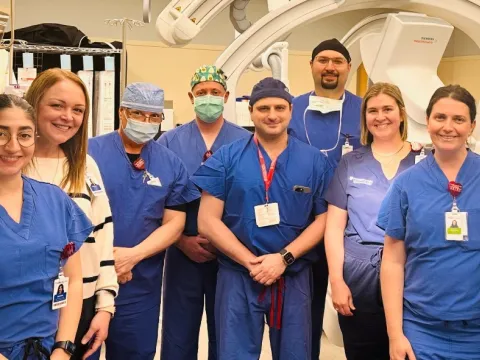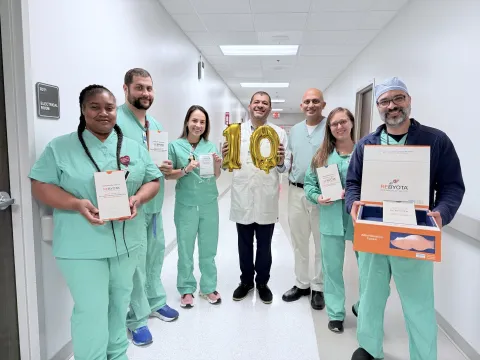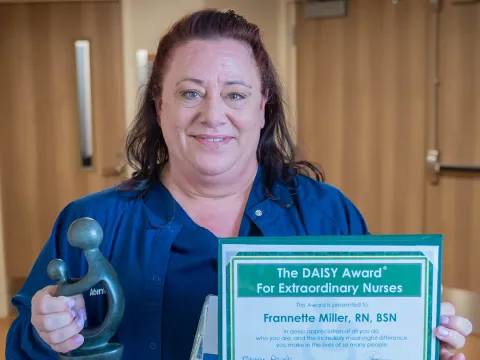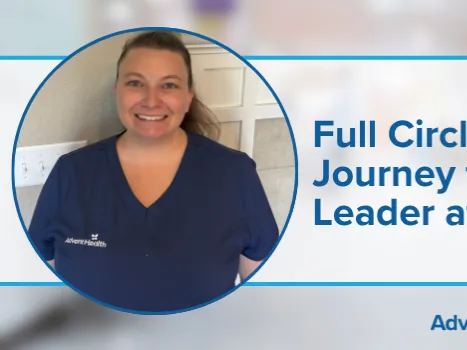- AdventHealth

A stroke is a sudden medical emergency that affects someone every 40 seconds in the United States and is one of our country’s leading causes of disability. According to the CDC, anyone can have a stroke at any age, but certain factors can increase your likelihood of a stroke. These include high blood pressure, high cholesterol, heart disease, diabetes, family history and risky health behaviors such as smoking or drinking too much alcohol. Your lifestyle can also increase your risk of stroke which is why it’s important to maintain a relationship with your primary care physician to take steps to maintain a healthy lifestyle.
Stroke Coordinator Heather Guthrie, RN, coordinates both the stroke response teams at AdventHealth Gordon and AdventHealth Murray but also helps educate the community on what to look for to recognize and respond to a stroke.
“Time is tissue, time is brain,” said Guthrie. “Every minute we lose almost 2 million neurons during a large vessel stroke so you have to get to the emergency room and get treatment to stop the stroke so we can prevent death and disability.”
Guthrie has witnessed patients arrive at the hospital during a stroke, receive rapid treatment and walk out of the hospital and go on to live normal lives. For example, a patient arrived with complete paralysis of their left arm and leg and also had some issues with slurred speech. The patient called 911 within 15 minutes of the symptoms beginning. The AdventHealth Gordon EMS team called a stroke alert ahead of the patient’s arrival. Nurses, radiology staff and the tele-neurology team were on standby at the CT scanner when the patient arrived, and within 30 minutes of arrival, the team had determined the patient was eligible for the “clot-busting” thrombolytic medication. Within 30 minutes of initiating the treatment, the patient was able to move their arm and leg.
The best-case scenario, Guthrie says, is if the symptoms are recognized immediately and our team is able to intervene and help the patient. She says every friend or family member should understand these symptoms to recognize the onset of a stroke.
“Knowing what stroke symptoms look like by using the B.E. F.A.S.T. acronym can save your life or a loved one’s,” said Guthrie.
What is a Stroke?
A stroke happens when blood flow is blocked to part of your brain (ischemic stroke) or a blood vessel suddenly bursts (hemorrhagic stroke). These events can cut off blood and oxygen supply to your brain and damage brain cells. Long-term physical damage can occur if a stroke is left untreated or care is delayed.
How to B.E. F.A.S.T
Remember the signs and symptoms of a stroke by using the acronym B.E. F.A.S.T., which stands for:
- Balance: Does the person have trouble with balance, coordination or dizziness?
- Eyes: Is the person experiencing sudden blurring or loss of vision in one or both eyes?
- Face: When the person smiles, does one side of the face droop?
- Arms: Does the person have arm or leg weakness?
- Speech: Is the person’s speech slurred? Can they repeat a simple sentence?
- Time: If the person has any of these symptoms, call 911 immediately.
Similar to heart attacks, stroke symptoms can vary between men and women. You should specifically look out for these stroke symptoms in women:
- Agitation or sudden behavioral change
- Difficulty breathing
- General weakness
- Hallucination
- Hiccups
- Loss of consciousness
- Nausea or vomiting
- Pain
- Seizures
It is recommended to call 911 right away if you or a loved one are experiencing stroke symptoms.
“Do not drive yourself or your loved one. Call for an ambulance instead,” said Guthrie. “When EMS is activated, they are able to call in a stroke alert to the hospital during the ride, and the ER team is waiting for them to walk through the door to take rapid care of the patient.”
Receiving immediate, life-saving medical care for a stroke increases a patient’s chances of survival and reduces long-term harm, such as difficulty walking, speaking or eating, explained Guthrie.
Expert Stroke Care When You Need It Most
If a person shows any stroke symptoms, call 911 immediately. Fast stroke intervention means that our physicians and ER experts can give your loved ones medicine and treatment that helps restore blood flow to their brain and stops further damage.
Residents in Gordon and surrounding counties can receive world-class neurology and stroke diagnoses closer to home through our telemedicine program. This program allows patients to have access to a network of neurologists specially trained in diagnosing and treating strokes via a real-time video conference when they arrive in the emergency room.
Choose the health content that’s right for you, and get it delivered right in your inbox.
Recent News
Two women in Lake County that have been best friends since high school have now given birth to two beautiful babies just hours apart. FOX 35's Kelsie Cairns spoke to both the mothers, as well as the...
Dr. Matthew Villani, a foot and ankle surgeon with AdventHealth Medical Group located at AdventHealth Waterman, joined FOX 35 Orlando to address a common seasonal issue: foot and ankle injuries.
As...
AdventHealth Millenia ER is celebrating its first anniversary of providing lifesaving, whole-person care to residents and visitors in West Orlando.
Anesthesia Associates of Kansas City becomes a strategic partner for the rapidly growing hospital in south Overland Park.
UChicago Medicine AdventHealth Hinsdale now offers life-saving stroke care with a new minimally invasive procedure, improving survival rates and quality of life.
The hospital’s three-story expansion will be completed in summer 2026.
AdventHealth Zephyrhills is leading the way in Pasco County with a new treatment for clostridioides difficile or C. diff.
AdventHealth is proud to introduce you to Frannette Miller, BSN, RN, winner of our DAISY Award for the ray of light she shines on the lives of her patients every day in the Behavioral Health Unit at...
Dr. Jason Jennings, orthopedic surgeon with AdventHealth Medical Group Colorado Joint Replacement at Porter, was selected to present his research findings at the 3rd International Consensus Meeting on...
When it comes to back health, how you sleep matters just as much as how you move during the day. According to Dr. Sharad Rajpal, a neurosurgeon at AdventHealth Avista, your nighttime habits can either...
Personal experiences and the desire to give back inspired AdventHealth Avista ICU Manager Megan May to pursue a career in nursing. Her journey began in the very halls of Avista, where as a child she...
July marks Fibroid Awareness Month—a time to spotlight a condition that affects an estimated 26 million women across the United States.












